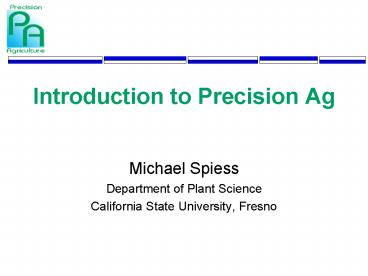Introduction to Precision Ag PowerPoint PPT Presentation
1 / 37
Title: Introduction to Precision Ag
1
Introduction to Precision Ag
- Michael Spiess
- Department of Plant Science
- California State University, Fresno
2
Its About Crop Yield VARIABILITY!
- Measuring
- Analyzing
- Managing
3
Sources of Crop Yield Variability
- Soil
- Texture
- Salinity
- Fertility
- Compaction
- Organic Matter
- Disease
- Pests
- Water Management
- Weather
- Crop Genetics
4
Its About Management
- Farming by the Square Foot
5
Building Blocks ofPrecision Agriculture
A smorgasbord of technologies.
Direct Remote Sensing
Variable Rate Technology
Yield Monitors
Precision Navigation
Global Positioning Systems
Geographic Information Systems
6
Precision Farming Cycle
Data Collection
Analysis
Farming
Management Decisions
7
What is GIS?
- Maps Data
- Layers
- History
- Analysis by Location
8
Why is GIS Important?
- Most data has a spatial component.
- GIS provides a method to
- Analyze the spatial component,
- Display the data spatially,
- And retrieve data spatially
- GIS is a MANAGEMENT TOOL
- Store traditionally collected data such as soil
samples - Foundation for Precision Ag.
9
Farm GIS Layers
- Layers for
- Fields (Crop, Plant Date)
- Soil Map (Soil Type, Soil Class, S.I.)
- Fertility (N,P,K,.)
- Yield Maps
- Aerial Photos
- Remote Sensing Data
- As Applied Maps
- Pump Locations (yields, pwl, last test, pump)
- Irrigation Distribution (pipe type, size)
- Streets (Name, size) and Buildings
10
Data Management Issues
- GIS data is valuable!
- GIS is an Information System and it requires
- Organization
- Regular Backup
- Management of Hardware and Software
11
GPS
Global Positioning Systems
Geographic Information Systems
12
What is GPS?
- Global Positioning System
- A satellite based positioning system
- Three Segments
- Space Segment - 24 satellites
- Control Segment (Military)
- User Segment (GPS Receiver)
13
GPS Constellation
14
User Segment
- Units receive transmission from Satellites
- Cost between 100 and 25000 (depends on
accuracy) - Must be line of sight with satellites
15
How does it work?
- Position of satellites is known.
- The speed of the radio signal from each satellite
is known - Very accurate timing allows the calculation of
the distance from each satellite. - Using triangulation, the position of the receiver
is calculated.
16
GPS
http//wwwhost.cc.utexas.edu/ftp/pub/grg/gcraft/no
tes/gps/gps.html
17
Differential GPS (DGPS)
- Used to correct for GPS errors
- Uses a ground station at a known location
- Ground station measures error of GPS signal by
comparing the known location with the GPS
location - In real-time, the error transmitted to DGPS unit
and position is corrected.
18
Differential GPS (DGPS)
http//wwwhost.cc.utexas.edu/ftp/pub/grg/gcraft/no
tes/gps/gps.html
19
Accuracy
- Usually given as the radius for percent of
readings (50, 68, 95) - GPS with Selective Availability off 13 m
- DGPS 1-3 m
- RTK GPS (2 cm)
20
Example Accuracy
21
Yield Monitoring
Yield Monitors
Global Positioning Systems
Geographic Information Systems
22
Yield Monitoring
- Measuring yield on the fly
- Small Areas 100-1000 square feet
- Crops
- Grains
- Cotton
- Potatoes, sugar beets
- Peanuts
- Tomatoes
23
Yield Maps
Field 18Yield 2.25 Bales/Acre
24
Direct Remote Sensing
Direct Remote Sensing
Yield Monitors
Global Positioning Systems
Geographic Information Systems
25
Remote Sensing
- Typically sensing from aircraft or satellite
- Sensing of visible and invisible electromagnetic
spectra - Commonly Blue, Green, Red, Near IR
- Typically 1m to 15m resolution
- Used to
- detect plant stress
- base mapping
- grape harvest
- map soil texture
26
Sample 2m Data
27
Direct Sensing
- Sensor is in direct contact
- Soil Conductivity
- Veris
- Electromagnetic sensors (Geonics EM-38)
- Soil moisture
28
Soil Conductivity
29
Grid Sampling
- Example Nitrate Nitrogen
- Max 115
- Min 9
- Mean 47
- SD 30
30
Precision Guidance
Direct Remote Sensing
Yield Monitors
Precision Guidance
Global Positioning Systems
Geographic Information Systems
31
Precision Guidance
- Tractor guidance at the centimeter level using
GPS - Benefits that may be achieved
- Increased speed of operation
- Operates at night and in fog
- Reduced cost of tractor ownership
- No guess row
- Reduce chemical cultivation costs
- Beds can be located over buried drip
- Increased field efficiency (0 overlap)
32
Technologies
- RTK GPS (2 cm)
- Portable or Fixed based stations for correction.
- Manufacturers
- Beeline
- IntegriNautics (AutoFarm)
- Trimble
33
Issues in Guidance and Operation
- Accuracy of the GPS
- Location of the antenna with respect to the
ground - Guidance between GPS readings (1/sec,
5mph7ft/sec) - Setup of tractor and implements
- System management to insure repeatability
34
Variable Rate Technology
Direct Remote Sensing
Variable Rate Technology
Yield Monitors
Precision Navigation
Global Positioning Systems
Geographic Information Systems
35
What is VRT/VRA?
- Also called Variable Rate Application (VRA)
- Site specific application of materials
- Used for
- Fertilizer and Soil Amendments
- Seeding
- Herbicide and Pesticides
- Material can be liquid or dry
36
VRA Methods
- Application Maps (GIS)
- Requires GPS location
- Method of creating map (software)
- Ex. Use soil sampling data to create a variable
rate application map. - Sensor
- rate is varied by sensor on the applicator.
37
Economic Issues
- PA technologies can be expensive to implement
- Return on investment will vary highly by
individual situation - Not all technologies are suited for a given crop
- Some benefits are easy to identify, others are
not.

